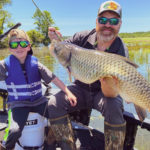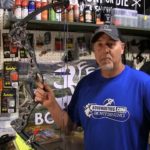As an optometrist I am frequently asked to give my opinion on sunglasses or eyewear that are best suited for fishing, OK, more times than not it’s asked by the local bass tourney fisherman but the topic applies to us bow fishermen as well.

We must first understand that the primary objective of the sunglasses is to allow us to see into the water as deep and as clearly as possible.
The other objective not to be forgotten is that our eyewear should reduce eyestrain and squinting while on the water as much as possible. Fortunately for us, we have a lot of choices at this time.
#1 Polarization
The sunglasses must use true polarized lenses if they are going to remove the glare which is what hinders our ability to see into the water.
I won’t go in to the physics of sunlight and the manner in which it produces glare at the water surface but please understand to remove as much glare as possible that the lenses must be truly polarized.
Most sunglasses will likely be marked as to whether they are polarized, and if it is not clearly stated then they are probably not polarized.
All polarized lenses are not equal and some will remove the glare better than others.
A little trick you can use to tell if the lenses are polarized is to view an automobile rear window in the bright sunlight and if it appears to have an almost checkerboard appearance when viewed thru the sunglasses then they are polarized.
This isn’t necessarily true in all cases but it’s a good starting point. Another way you can check on polarization is if you have a pair of sunglasses that you know are polarized then lay the sunglasses in question on top of the known pair of sunglasses, lens on top of lens facing one another.
Then turn one pair of sunglasses so they are now at 90 degrees to the other and you should notice a substantial darkening affect as the lenses are turned on one another.
Please realize that like most things in life, there are different qualities of polarization and the more expensive the lenses the more likely they are of higher quality.
#2 Quality Optics
Try to make sure the sunglass lenses optics are of decent quality.
I have seen countless cases where people present to my office complaining of headaches after driving a short time while wearing sunglasses only to find that the poor optics of those sunglasses are the source of the problem.
We will often find significant aberrations in the lens and/or poor optics in general which can easily cause eyestrain and headaches.
In my office I can evaluate the lens optics by using a lensometer or one can even get a quick idea of the quality of the optics by holding the glasses up in front of a chart projector and evaluating how blurred the projected image becomes.
Obviously you can’t do that at home but you can hold the glasses up several inches from your face while viewing a consistent grid like a sheet of graph paper and by turning the lenses slightly and moving the glasses slowly back and forth and up-down while looking for areas of curved lines and/or distortion of the distant pattern.
Please understand that many of today’s wrap-around type of sunglasses will have at least some distortion in the very extreme side or periphery of the lenses which is due to the induced astigmatic error.
To some degree, this is unavoidable but you would like this to be as minimal as possible. Again the rule of thumb is don’t expect the $2 sunglasses at the gas station to be as high as quality as a pair of Bausch and Lomb Ray Bans.
#3 Lens Tint
Select the color or tint that works best for you. I am often asked which color sunglasses work best for bowfishing and to be honest, there is no single best color for every person and every shooting situation.
Gray lenses tend to alter the color vision spectrum the least in relation to the human eye and make for a good all-around pair of sunglasses that might be used for other activities as well.
For what it’s worth, this is the color of lenses that I use for 80% of my shooting in bright sunny conditions. But I will tell you that many individuals prefer a different color for various conditions.
I once made up several pair of prescription polarized sunglasses for a fellow bowfisherman that wanted a very deep pink or rose colored lens that he felt enabled him to spot fish more easily in stained water.
Though I personally was unable to see a dramatic improvement it’s hard for me to argue with someone that has won several national bowfishing tournaments.
Some individuals feel that an amber or yellow lens performs better on a cloudy day or when the sun’s rays approach the water surface at a more acute angle such as near sunrise or sunset.
These lenses are often described as Hazemaster, Blue Blocker, or shooting tints and these lenses do seem to improve contrast sensitivity for some individuals. Even dark brown and dark green lenses have their fans as well so my recommendation is to try several colors and see which tints work best for you.
#4 Ultra violet ray protection
Make sure the sunglasses you purchase have the ability to absorb 100% of the sun’s harmful ultra violet rays.
Remember while on the water you are actually getting a double dose of UV, those rays directly from the sun and those rays that are bouncing off the waters surface.
The more we learn about ultra violet light and its effects on the human eye, the more we realize just how damaging long term exposure can be.
Significant exposure to UV rays has been shown to cause the development of cataracts at an earlier than normal age and may well increase the likelihood of eye disease such as Age-Related Macular Degeneration which happens to be the leading cause of blindness for those over 65 years old.
Please understand that younger bowfishermen are not immune to these effects and may be even more susceptible to harmful UV rays since the pupil size of a child’s eye tends to be so much larger than an adult pupil and hence more UV is allowed to enter the eye.
In fact it may be the larger amounts of UV that we take in as children that comes back to haunt us as we age.
#5 Glass or plastic lenses and a word on cost.
In general, plastic lenses scratch more easily than glass lenses but they tend to weigh half as much as glass and are much more shatter resistant than glass lenses making them safer if used around flying objects (think snapback of an arrow).
Polycarbonate lenses are a type of plastic lens that is even more shatter resistant than standard CR-39 plastic lenses and are often used in safety glasses.
Many plastic lenses will have a scratch resistant coating; notice I said scratch resistant and not scratch proof as no such coating exists.
Often the more expensive plastic lenses will have a better scratch resistant coating. It used to be that glass lenses tended to have better optics than plastic lenses but that is not the case anymore.
Plastic lenses can offer exceptional optics and when you figure in the safety factor, that is why I tend to wear plastic lenses when on the water.
When it comes to costs you don’t have to spend $200-$300 for a pair of exotic sunglasses like Maui Jims in order to get a good pair of sunglasses with quality optics.
Expensive sunglasses like these are very nice but there is a tremendous amount of price mark up with these things and you’re not getting any better optics or polarization than say a much less expensive pair of Bausch and Lomb Ray Bans.
The law of diminishing returns often applies to the price of sunglasses.
If you normally wear prescription eye glasses, don’t forget that you can have your local eye doctor or optical fabricate a polarized pair of sunglasses made with your prescription, in the frame of your choice, and with the tint of your choice.
If you don’t want to go to this expense, consider purchasing a pair of polarized wrap-around Fitovers that can be placed over your prescription eye glasses.
This solution isn’t quite as nice as having a pair of polarized prescription sunglasses since you’re now adding a second reflective surface in front of the eye but it’s fairly cheap and easy.
And finally, remember that after your bow and arrow, your polarized sunglasses are the next most important piece of gear when it comes to daytime bowfishing, so choose with care.





